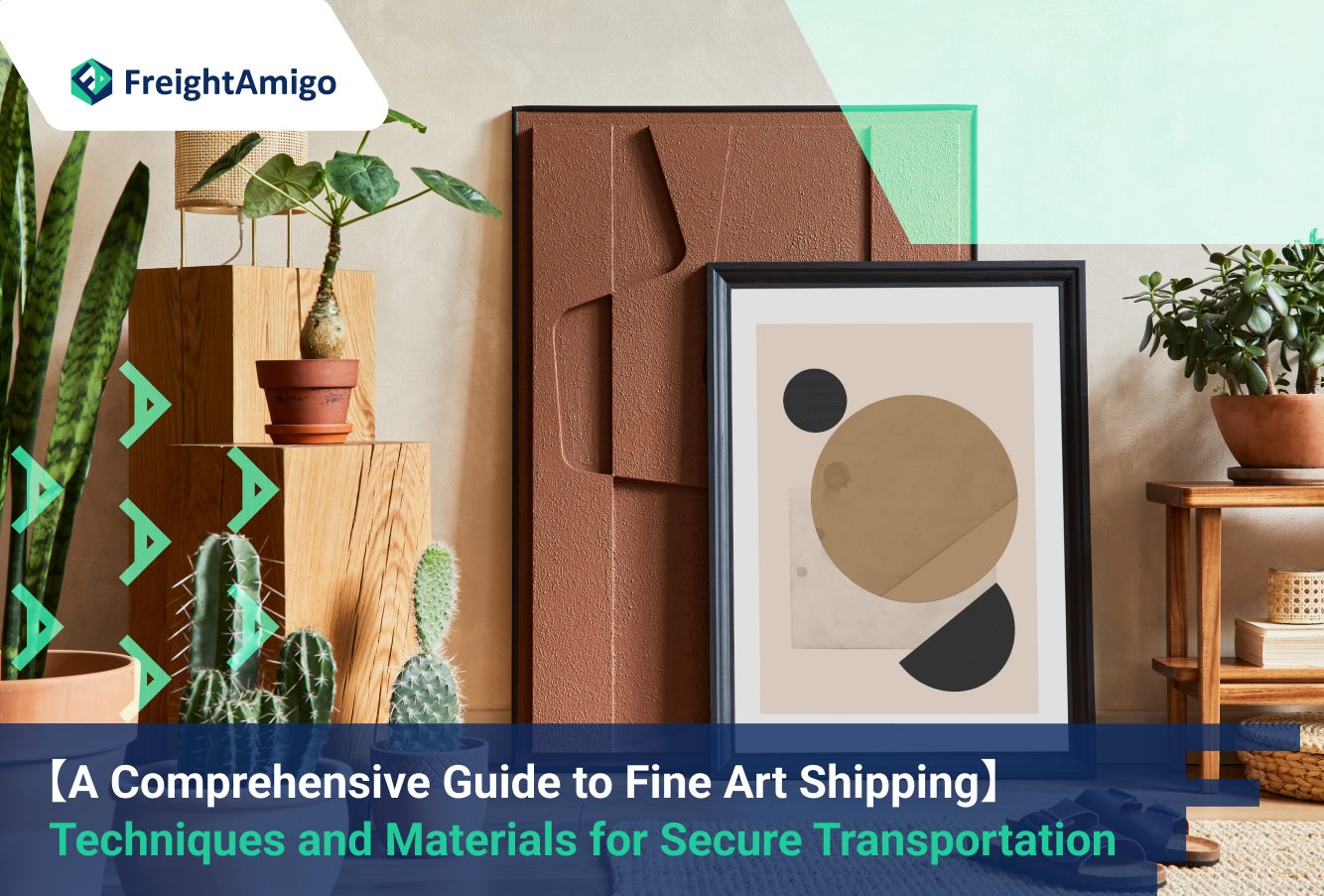Author Name: Tiffany Lee – Marketing Analyst at FreightAmigo
Fine art shipping requires careful consideration and expert handling to ensure the safe transportation of valuable and fragile artworks. Whether you are an artist shipping your work to a gallery or a collector sending a piece to a new location, it is essential to understand the techniques and materials used to protect and secure artwork during transit. In this comprehensive guide, we will explore the best practices and innovative solutions that can enhance the shipping experience and ensure the preservation of fine art.
Want To Compare The Best Express, Air Freight, Sea Freight, Rail Freight & Trucking Rates So As To Have Better Control On Cost?
The Importance of Proper Packing and Shipping
Shipping fine art requires meticulous planning and attention to detail. Artworks are often delicate, valuable, and irreplaceable, making their safe transportation a top priority. Poor handling, rough roads, and inadequate packaging can lead to significant damage or even the loss of a piece. Therefore, it is crucial to invest in proper packing materials and techniques to ensure the artwork arrives at its destination unharmed.
Artists, collectors, galleries, and museums must prioritize the protection of their artworks during transit. This involves understanding the specific requirements of each piece, assessing shipping needs, and selecting the appropriate packaging materials and techniques. By taking these precautions, you can minimize the risk of damage and ensure the longevity of your artworks.
Fine Art Packaging Materials: Choosing the Right Supplies
Selecting the appropriate packaging materials is crucial to ensure the safe transportation of fine art. Here are some essential supplies to consider:
Foam Core
Foam core is a lightweight material that provides excellent protection for artworks. It can be easily cut to size and is commonly used for packing, shipping, and storage. Foam core is available in various thicknesses, making it versatile for different artwork sizes and fragilities.
Acid-Free Paper
Acid-free paper is essential for protecting artworks from potential damage during transportation. It is pH neutral and does not cause chemical reactions with the art. Glassine, a type of acid-free paper, is also air, water, and grease resistant, making it an excellent choice for wrapping delicate pieces.
Bubble Wrap
Bubble wrap is a popular and effective packing material due to its cushioning and shock-absorbing properties. It provides protection against impact and prevents movement within the packaging. When using bubble wrap, ensure that the bubbles face outward to avoid impressions on the artwork.
Packing Tape
Invest in high-quality packing tape that ensures secure seams and protects against moisture. Look for tape specifically designed for shipping purposes to ensure its durability and reliability.
Corner Protectors
Corner protectors are crucial for protecting the vulnerable corners of flat artworks. They reduce the risk of warping or scoring during transit. Foam or cardboard corner protectors can be purchased or made at home using acid-free tissue paper.
Customized Crates
For delicate, large, heavy, or irregularly shaped artworks, customized crates provide the best protection. These wooden containers can be built precisely to fit the specifications of the artwork, ensuring its safety during transportation.
Padding and Protecting Artwork: Techniques for Secure Transportation
Proper padding is crucial for protecting artwork from damage during transit. Here are some techniques to ensure secure transportation:
Pad the Boxes
When shipping 3D art pieces, it is essential to pad the boxes to create a secure compartment. Place a layer of cardboard in the larger shipping box to create a protective space for the smaller inner box. Fill empty spaces within the box with bubble wrap or crumpled-up tissue paper to provide cushioning and prevent movement.
Choose the Right Box Size
Select a box that is 2-3 inches larger than the artwork on each side. If the artwork is too large for a standard box, consider combining multiple boxes or customizing a larger container. Ensure that the box is sturdy and can withstand the weight and dimensions of the artwork.
Wrap the Artwork
Wrap each artwork individually using acid-free paper or glassine. This protective layer prevents damage to the artwork’s surface and provides an additional barrier against moisture. If shipping multiple paintings in one box, wrap each piece separately and use sheets of cardboard or foam to separate them and prevent rubbing.
Add a Hanger
If shipping a framed painting, add a hanger to the back of the artwork. Use a soft material, such as felt or velvet, to prevent scratching the frame. Ensure that the hanger is securely attached to prevent it from falling off during transit.
Wrapping Techniques: Safeguarding Art from Damage
Proper wrapping techniques are essential for safeguarding artwork during transportation. Consider the following tips:
Use Acid-Free Paper or Glassine
Wrap each artwork in acid-free paper or glassine to protect it from potential damage. These materials are pH neutral and do not react chemically with the artwork. They provide a protective barrier against moisture, air, and grease.
Bubble Wrap as a Second Layer
Bubble wrap can be used as a secondary layer of protection for delicate artworks. Place a sheet of bubble wrap over the artwork and secure it with tape. Be cautious not to let the bubble wrap touch the painting’s surface, as it can cause damage. Bubble wrap acts as a cushioning agent and prevents unwanted movement within the packaging.
Multiple Layers for Fragile Artworks
For particularly fragile artworks, consider using multiple layers of wrapping materials. This adds an extra level of protection and minimizes the risk of damage during transit. Be mindful of the artwork’s specific requirements and consult with professionals if needed.
Customized Wrapping Techniques
Each artwork may require a unique wrapping technique based on its size, fragility, and medium. Consulting with art handling professionals or researching specialized wrapping methods can help ensure the best possible protection for your artwork during transit.
Labeling and Documentation: Ensuring Clear Communication
Clear labeling and documentation are essential for efficient and secure art shipping. Consider the following aspects:
Fragile and Handling Instructions
Label the packaging prominently with “fragile” stickers or indications. This alerts handlers to exercise caution when handling the artwork. Additionally, provide clear instructions for unpacking and handling the artwork upon arrival to minimize the risk of mishandling.
Artwork Information
Include a label or document inside the packaging that provides detailed information about the artwork. This should include the artwork’s name, dimensions, medium, artist name, and any other relevant details. This information ensures that the artwork is easily identifiable and helps prevent any confusion during transit.
Shipping Documentation
Maintain detailed shipping documentation, including tracking numbers, insurance information, and any required customs forms. This documentation serves as a record of the artwork’s journey and provides essential information in case of any issues or inquiries.
Innovations in Fine Art Shipping: Advancements in Technology
Advancements in technology have revolutionized the fine art shipping industry, enhancing security, efficiency, and convenience. Consider the following innovations:
Climate Control Systems
Climate control systems maintain stable temperature and humidity levels during transit. This is particularly crucial for sensitive artworks that may be affected by fluctuations in environmental conditions.
GPS Tracking
GPS tracking allows you to monitor the location of your artwork in real-time. This technology provides valuable information about the artwork’s journey and ensures transparency and accountability throughout the shipping process.
Condition Monitoring
Condition monitoring systems use sensors to track and record environmental conditions, such as temperature, humidity, and vibrations. This technology allows you to monitor and analyze the conditions your artwork experiences during transit, providing valuable data for preservation and insurance purposes.
Online Platforms and Portals
Online platforms and portals have simplified the shipping process by providing easy access to shipping services, documentation, tracking, and communication. These platforms streamline the shipping experience and offer convenience and transparency for both shippers and recipients.
Conclusion: Ensuring a Seamless and Secure Shipping Experience
Fine art shipping requires expertise, attention to detail, and the use of proper techniques and materials. By following the best practices outlined in this guide, you can ensure the safe transportation of your valuable and fragile artworks. From assessing shipping needs to selecting the right packaging supplies and partnering with a reliable shipping service, each step plays a crucial role in ensuring a seamless and secure shipping experience. Embrace innovation and advancements in technology to enhance the convenience and security of your art shipments. By prioritizing the protection and preservation of your artworks, you can confidently navigate the world of fine art shipping and deliver your pieces safely to their destination.
Remember, the proper padding, wrapping, and securing of artwork are essential for successful fine art shipping. Invest in high-quality packaging materials, consult with professionals when needed, and always prioritize the safety and preservation of your valuable artworks.
There Are Different Options For Cargo Transportation. If You Want To Choose The Most Convenient And Suitable Solution, It Is Best To Have The Full Support Of Logistics Experts! If You Are Planning To Ship Goods Overseas, Please Go To The FreightAmigo Page For Inquiries.
===
Read More:
【Cosmetic Product Recycling】 A Guide to Sustainable Reverse Logistics
【Rise of Green Supply Chain】 Pioneering Sustainable Practices in Logistics
【ESG in Logistics】 How ESG Practices Drive Social Responsibility in Logistics
===
If you have any inquiries on logistics/supply chain, feel free to contact FreightAmigo now:
Chat with us online OR
Phone : +852 28121686
WhatsApp: +852 27467829









































